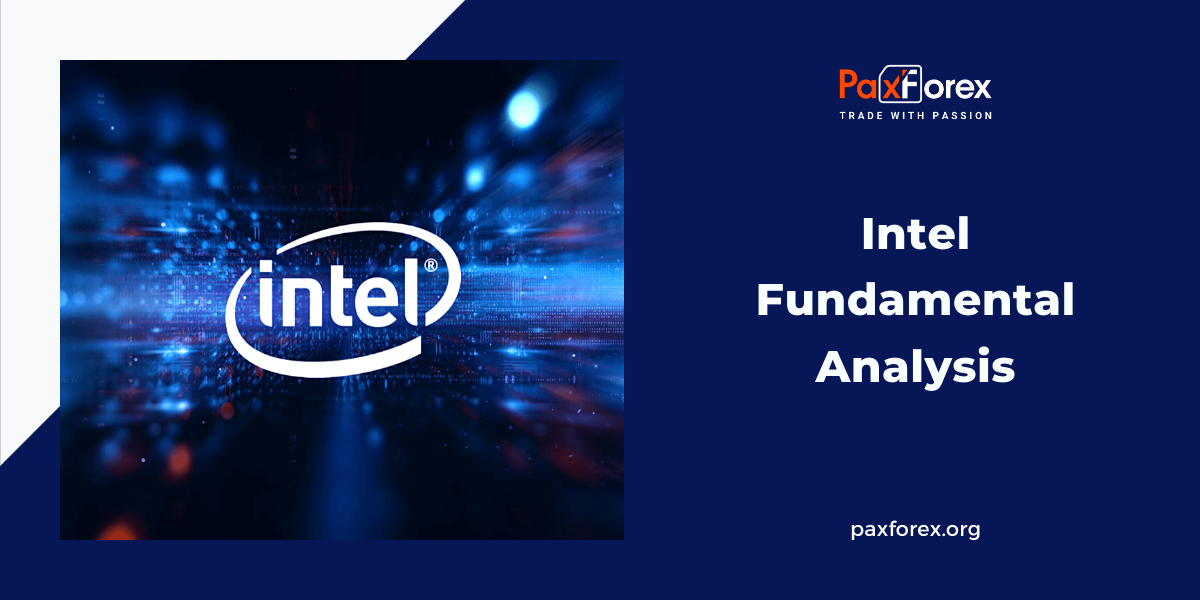
Source: PaxForex Premium Analytics Portal, Fundamental Insight
Intel, one of the largest chipmakers globally, has experienced a dramatic decline, losing over half of its market value in the past five years. The company has faced significant hurdles, including production delays, chip shortages, and fluctuating strategic decisions under various CEOs. However, with Intel's stock trading at its lowest levels in more than a decade, the question arises: is it worth investing in now?
As the leading producer of x86 CPUs for PCs and servers, Intel stands out for designing and manufacturing most of its chips in-house, unlike its smaller competitor, AMD, which outsources production to third-party foundries such as Taiwan Semiconductor Manufacturing (TSMC).
For many years, Intel led the industry in producing the smallest, densest, and most powerful x86 CPUs. However, each generational upgrade made the process of manufacturing smaller chips more complex and expensive. Many competitors, including AMD, eventually spun off their capital-intensive foundries and opted to outsource manufacturing entirely.
Intel, however, chose not to follow suit and remained a manufacturer, only to fall behind TSMC and Samsung in the race to produce smaller, denser chips. Efforts to close this gap slowed the development and production of its own chips, frustrating many of its customers. As a result, companies turned to AMD for a reliable supply of high-end chips produced by TSMC.
Intel’s x86 market share dropped significantly, falling from 82.2% in late 2016 to 62.8% by the fourth quarter of 2024, according to PassMark Software. Meanwhile, AMD's share surged, nearly doubling from 17.8% to 33.2% in the same period.
Adding to Intel’s challenges, the company missed out on two significant technological trends. First, it failed to capitalize on its dominance in the PC and server markets to establish a lasting presence in mobile chips, a market that Arm Holdings dominated by licensing more energy-efficient designs. Second, Intel didn’t anticipate the growing importance of discrete GPUs for artificial intelligence (AI) applications, a trend that prompted many companies to invest in Nvidia’s high-end GPUs for data centers instead of upgrading their CPUs.
Intel’s turnaround has been difficult, with three recent CEOs steering the company in different directions. Brian Krzanich, who stepped down in 2018, focused on diversifying beyond PC and server CPUs into areas such as programmable chips, automotive, the Internet of Things (IoT), and memory chips. His successor, Bob Swan, emphasized cost-cutting and stock buybacks, even considering the possibility of transforming Intel into a fabless chipmaker before his departure in 2021.
Pat Gelsinger, the architect of Intel’s i486 processor, returned as CEO and set out to modernize Intel’s foundries to catch up to TSMC and Samsung. He secured government subsidies for these efforts, but the gap between Intel and its Asian competitors has yet to close meaningfully.
Intel is reportedly contemplating the spinoff of its foundry, selling its programmable-chip business, and divesting other non-core operations. Gelsinger remains at the helm, but such moves could represent a complete reversal of his original strategy.
Between 2018 and 2023, Intel’s revenue dropped from $70.8 billion to $54.2 billion, and its earnings per share (EPS) plummeted from $4.48 to $0.40. The company also suspended its dividend earlier this year. This decline was driven by divestments, market share losses to AMD, shrinking PC sales, and macroeconomic challenges that are discouraging data centers from upgrading their CPUs.
Looking ahead, analysts are forecasting a compound annual growth rate (CAGR) of 4% for Intel’s revenue and a 38% CAGR for its EPS. These optimistic projections are likely based on the expectation that Intel will ramp up production of new chips, expand its third-party foundry business, and regain its process lead from TSMC and Samsung.
However, in its most recent quarter, Intel admitted to struggling with low yield rates for its new 18A process, which has impacted its gross margins due to the development of its AI CPUs, featuring enhanced AI processing capabilities. As a result, the company may miss Wall Street's long-term expectations.
Even if Intel meets these estimates, the stock does not currently offer a compelling value. At $22.50 per share, it trades at 113 times next year’s earnings and 24 times its 2026 earnings. In contrast, AMD and Nvidia, both growing at faster rates with fewer fundamental challenges, trade at just 48 and 33 times next year’s earnings, respectively.
Considering Intel’s uncertain turnaround strategy and the possibility of selling off parts of its business, the stock may not be a value investment at this point. It might become more appealing once the company provides clearer plans for its recovery, but for now, there are more compelling alternatives.
As long as the price is above 20.00, follow the recommendations below:
- Time frame: D1
- Recommendation: long position
- Entry point: 22.28
- Take Profit 1: 25.00
- Take Profit 2: 28.00
Alternative scenario:
If the level of 20.00 is broken-down , follow the recommendations below:
- Time frame: D1
- Recommendation: short position
- Entry point: 20.00
- Take Profit 1: 18.00
- Take Profit 2: 16.00













